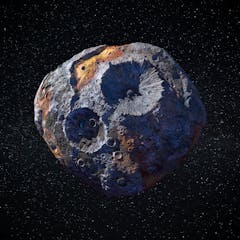
Articles on Asteroids
Displaying 21 - 40 of 169 articles

A new study of the meteorite Erg Chech 002 makes it one of the most precisely dated space objects and changes our understanding of how elements were spread around the cloud of dust that formed the Sun and planets.

Liftoff to the distant asteroid is scheduled for Oct. 5, 2023 – the beginning of a six-year journey to one of the most unusual objects in the solar system.

Research on the Deniliquin structure points to an asteroid impact that would have been more than double the scale of the one that killed the dinosaurs.

Barely a week goes by without headlines about a giant asteroid coming past Earth. Here’s what really makes an asteroid pass notable – it’s not just size.

A new survey catalogs Americans’ expectations about the future of space, from NASA to SpaceX. Two space policy experts describe how these results stack up against the current state of space affairs.

There is a very large scientific leap from observing a fireball to claiming it as an alien spaceship.

An asteroid ‘the size of 33 armadillos’ might be a flight of fancy, but real astronomers measure celestial objects with units that are just as strange.

The discovery of a key component of RNA in samples from asteroid Ryugu adds weight to the theory that basic organic molecules may have arrived on Earth from outer space.

In 2021, searchers recovered a meteorite that fell over the UK just hours earlier. Scientists have now reconstructed its story.

Five new studies show smashing spacecraft into asteroids could be a viable way to defend Earth from threatening space rocks.

Proponents of mining in space often point to the potential benefits for Earth and its people. But this research casts doubt on many of them.

Discovered less than a week ago, the truck-sized asteroid skimmed much closer to Earth’s surface than most satellites.

Rubble pile asteroids are like giant space cushions, floating around the Solar System for billions of years. Here’s what that means for planetary defence.

Geminids – the best meteor shower of the year – are about to grace the skies. Here’s everything you need to know.

From space to the outback, meteorite-tracking tools are building the knowledge we need to prepare for a future asteroid impact.

With a diameter between 1.1km and 2.3km, asteroid 2022 AP7 is the largest potentially hazardous asteroid found since 2014.

DART has forever changed the orbit of a small asteroid – and done so with much greater success than expected.

The Double Asteroid Redirection Test successfully showed that it is possible to crash a spacecraft into a small asteroid and change its orbit. This technique could save Earth from asteroids in the future.

Tiny glass droplets found on the Moon show Earth and its satellite have been hit by ‘waves’ of asteroid impacts in the past.

The Double Asteroid Redirection Test successfully showed that it is possible to crash a spacecraft into a small asteroid. Whether the approach could save Earth from a future threat remains to be seen.
